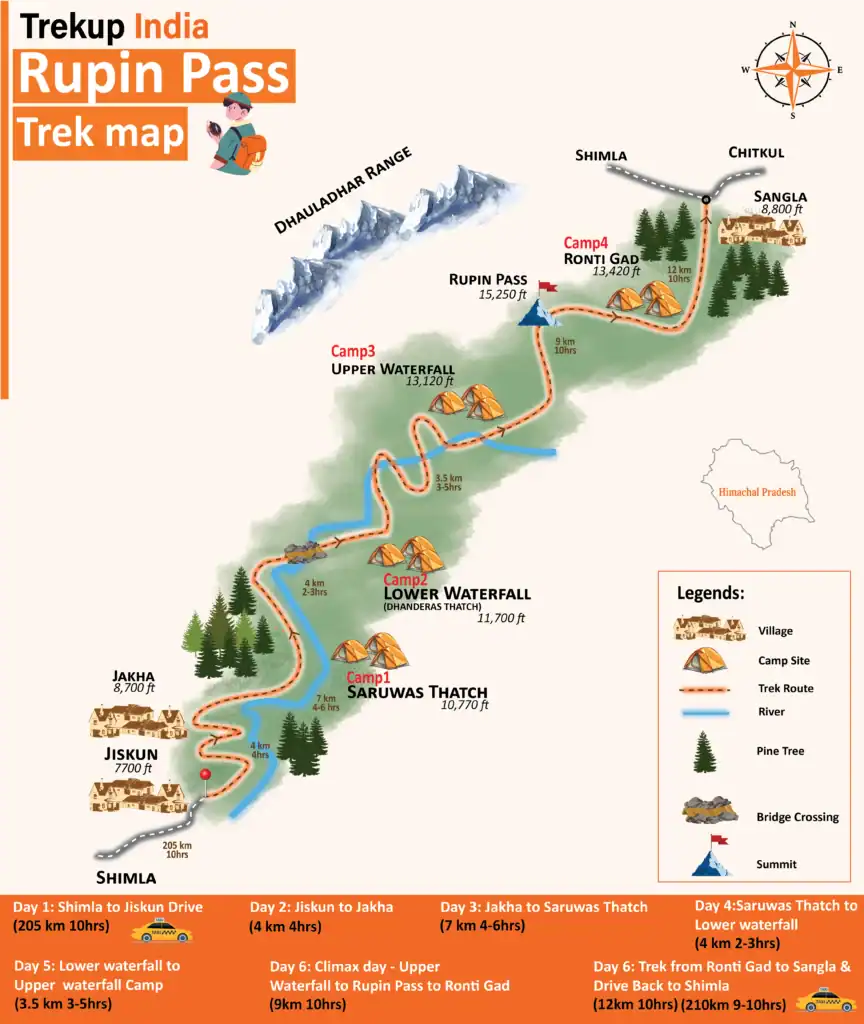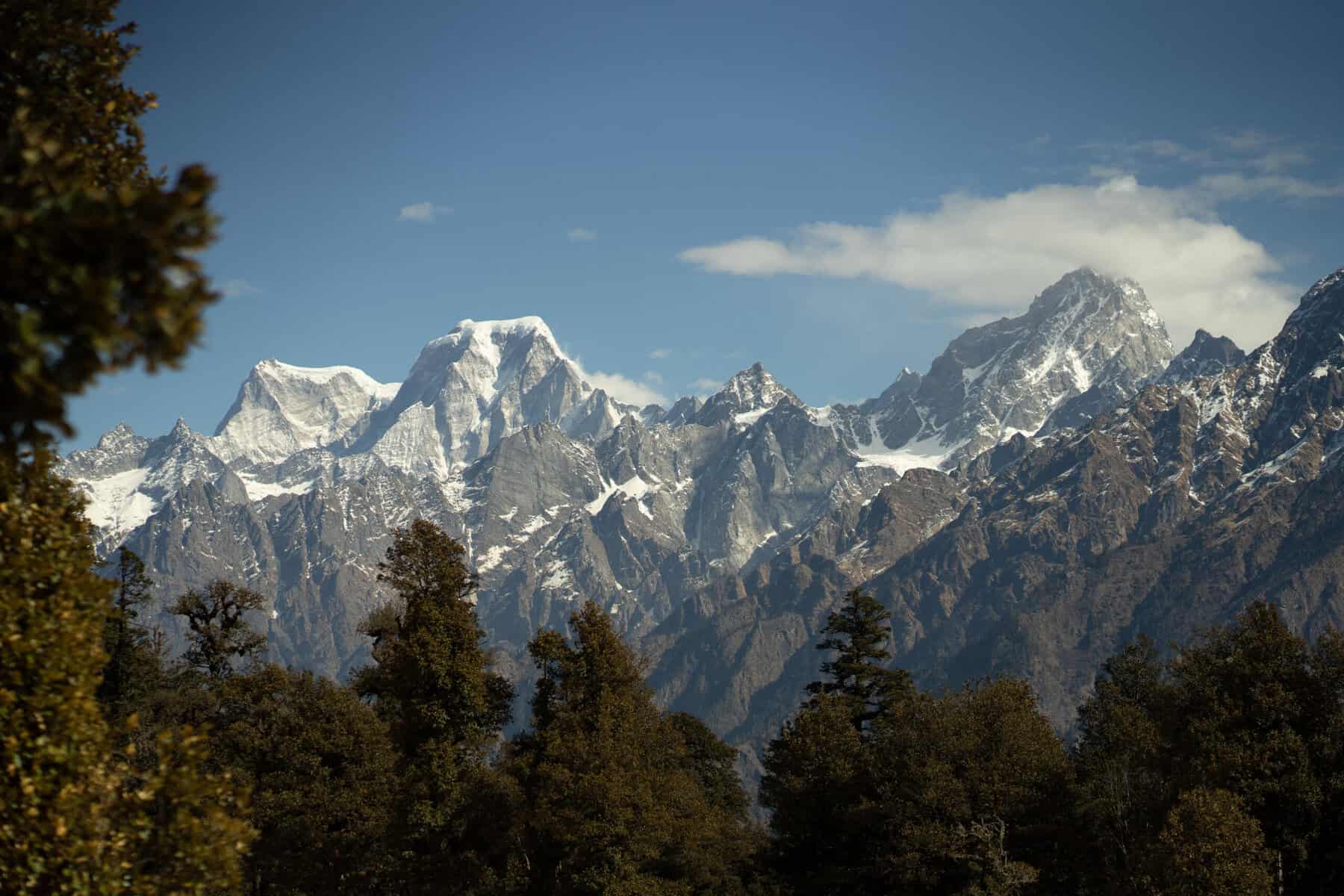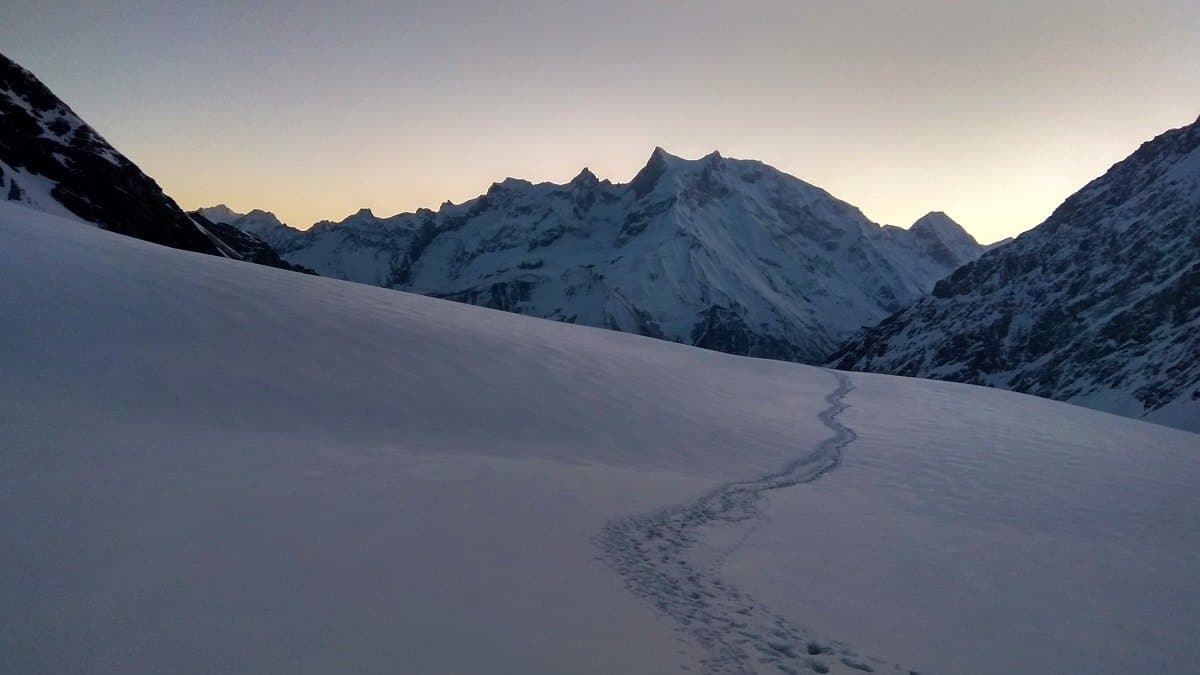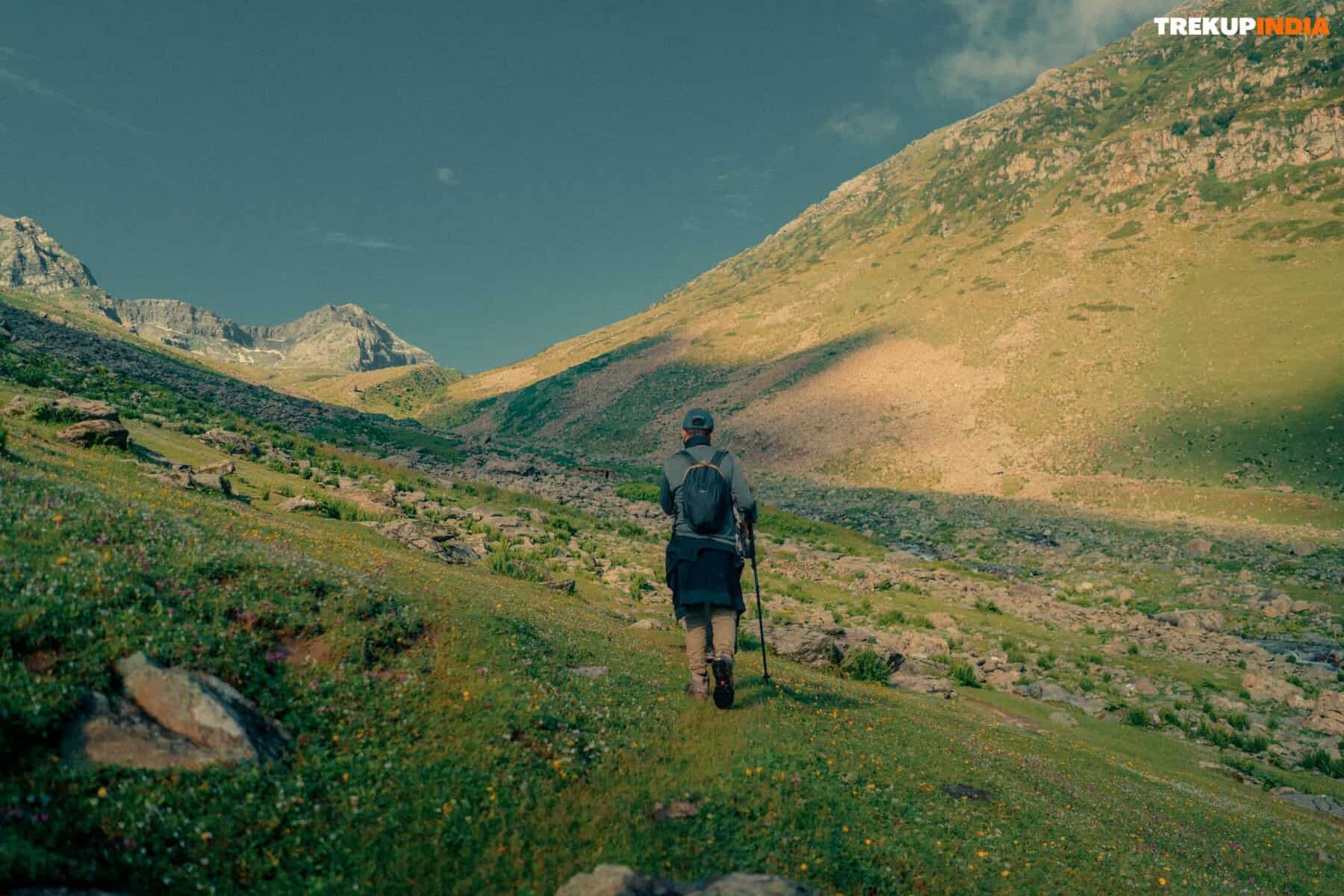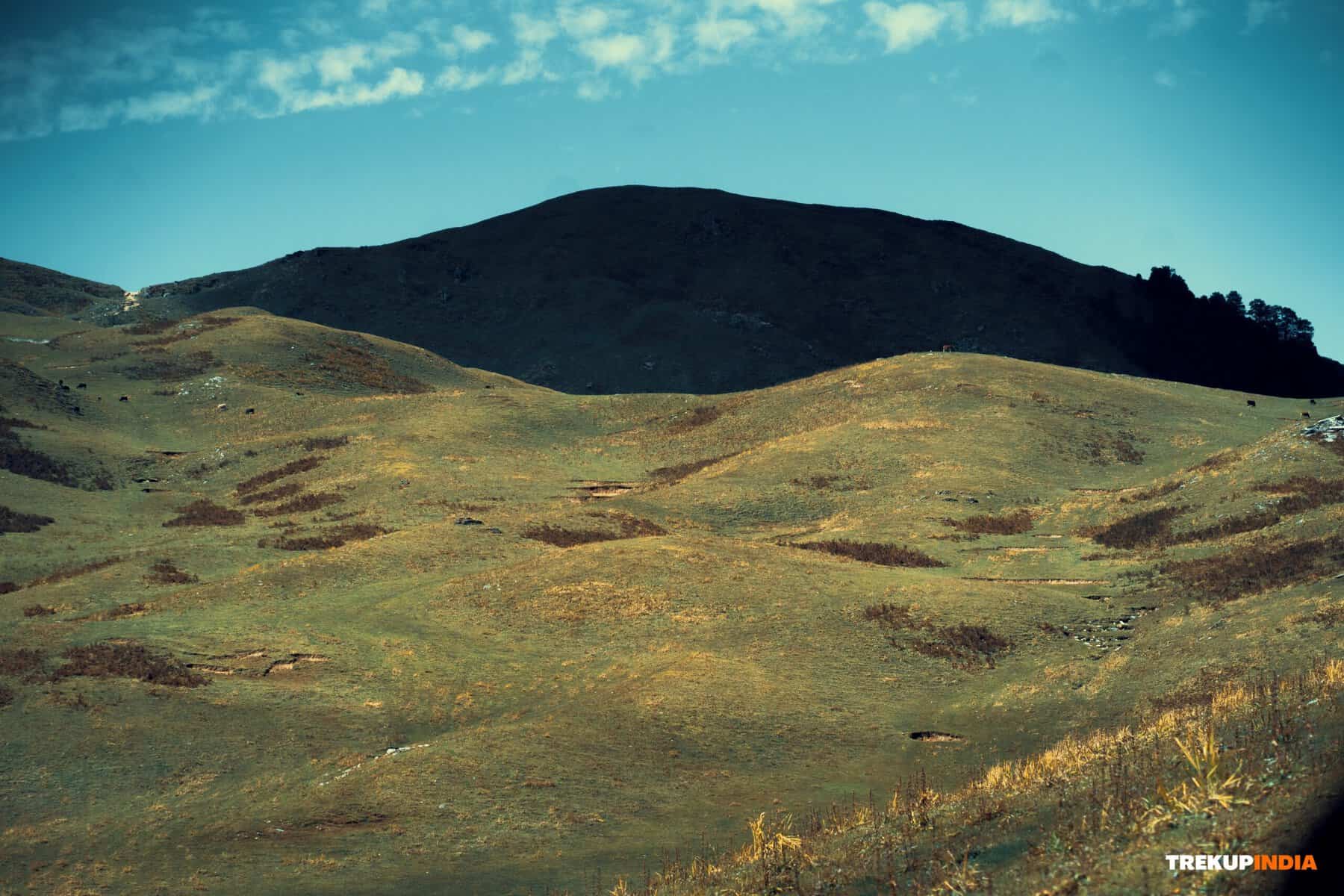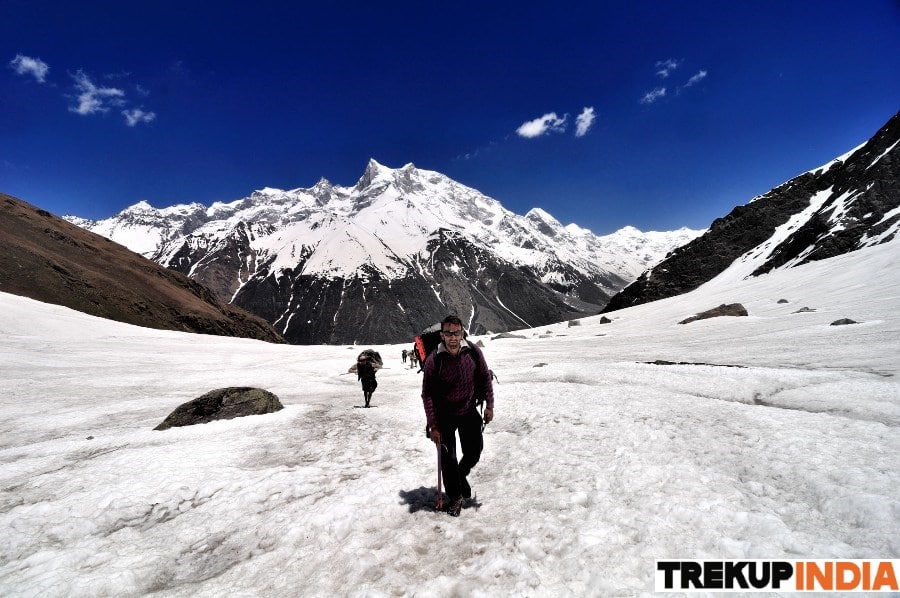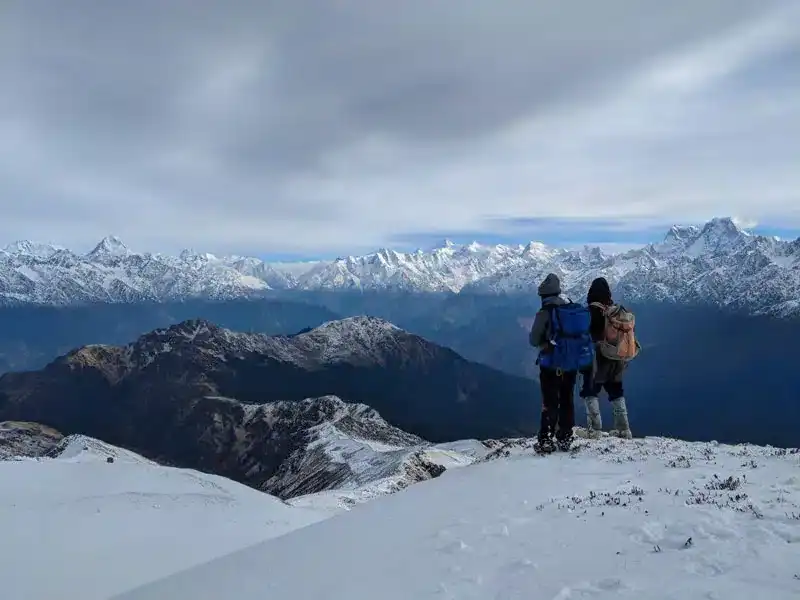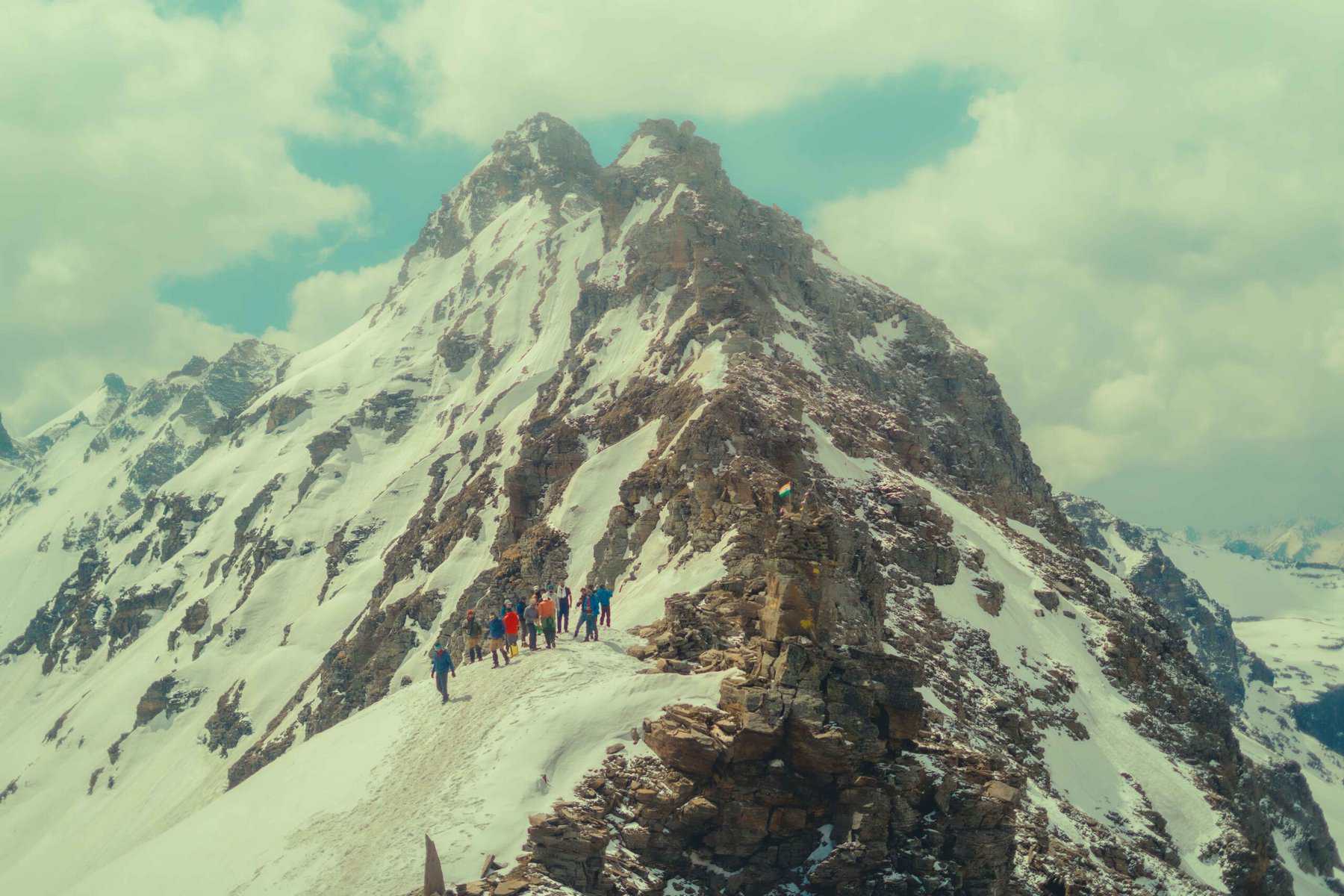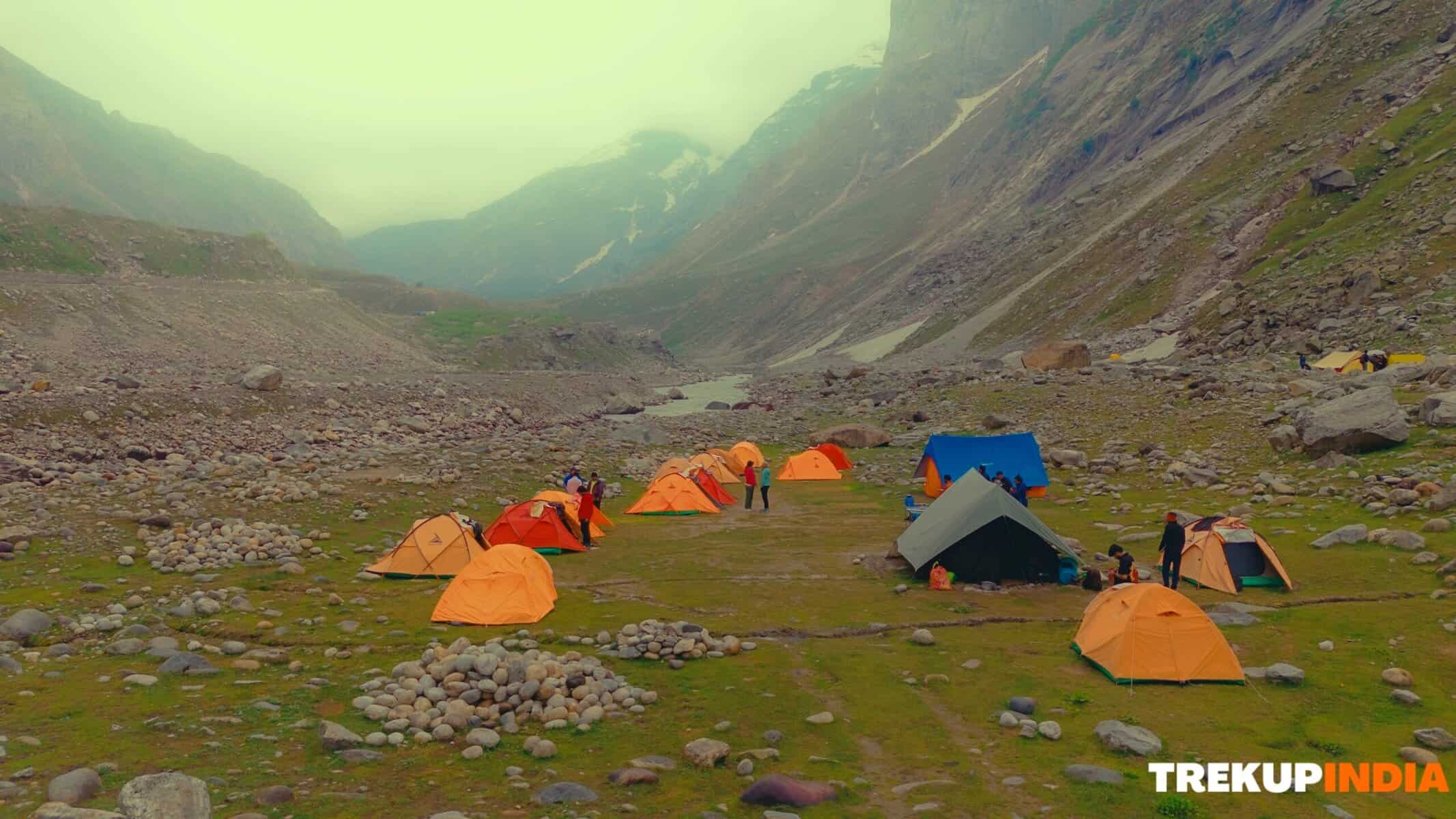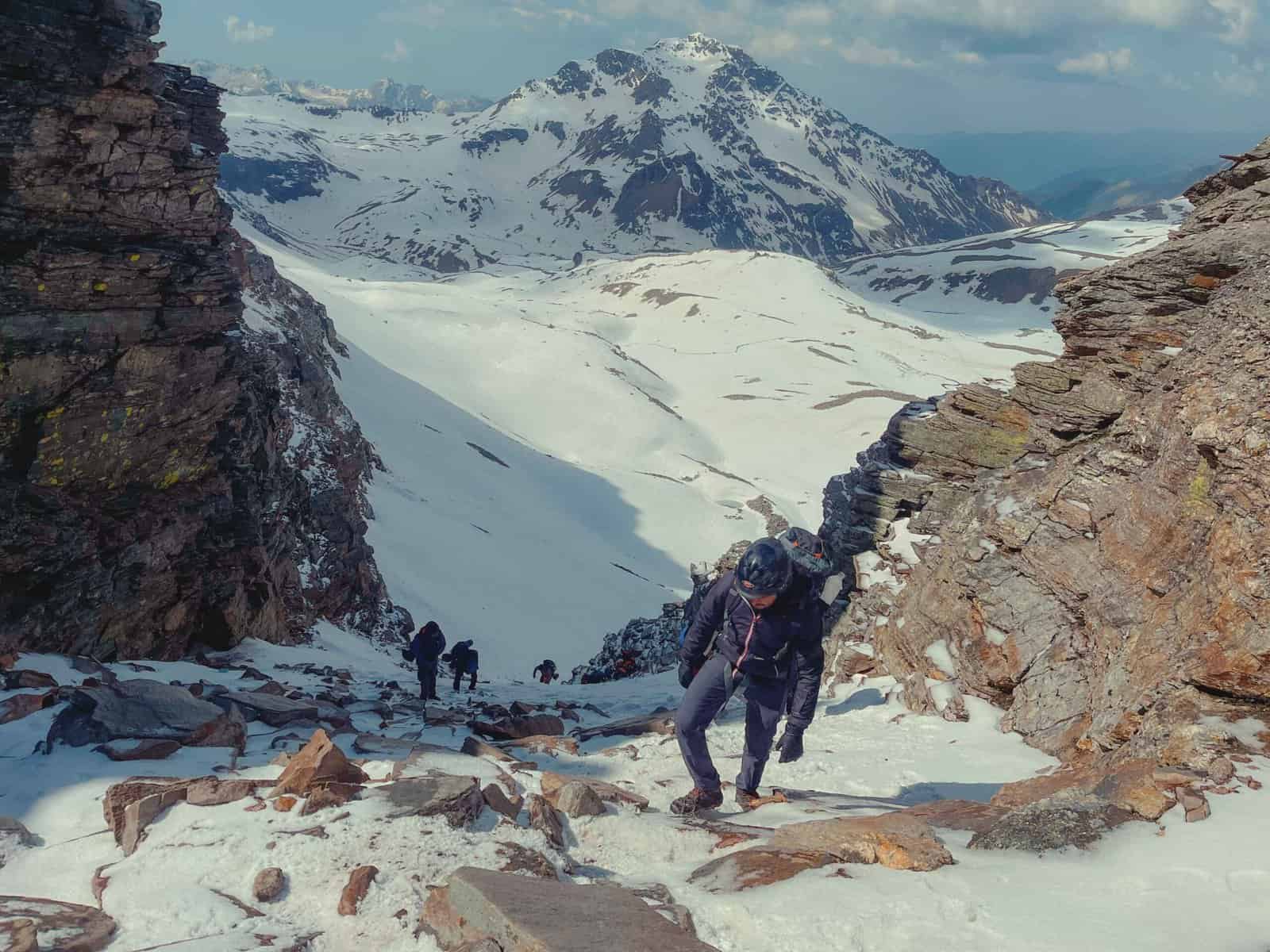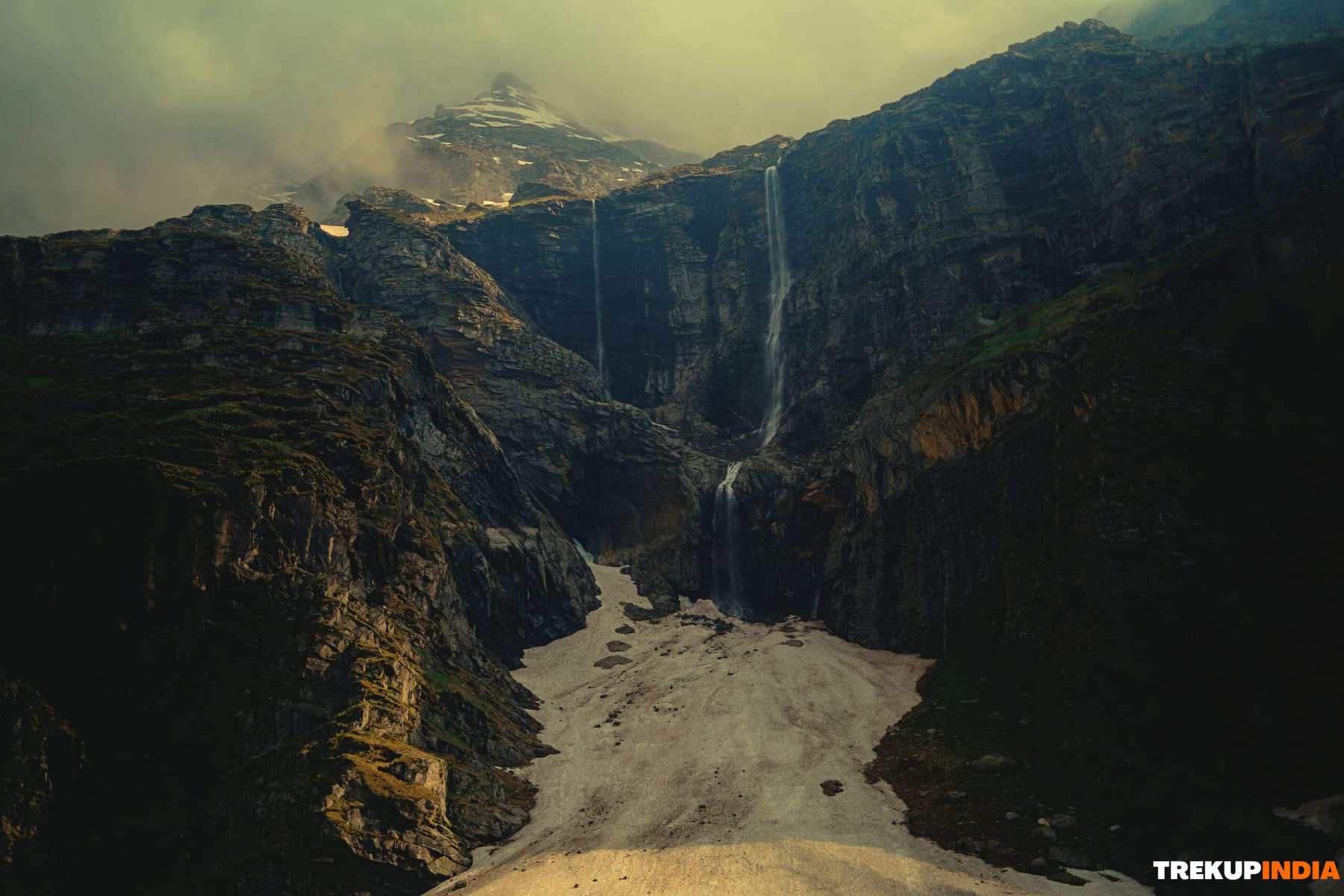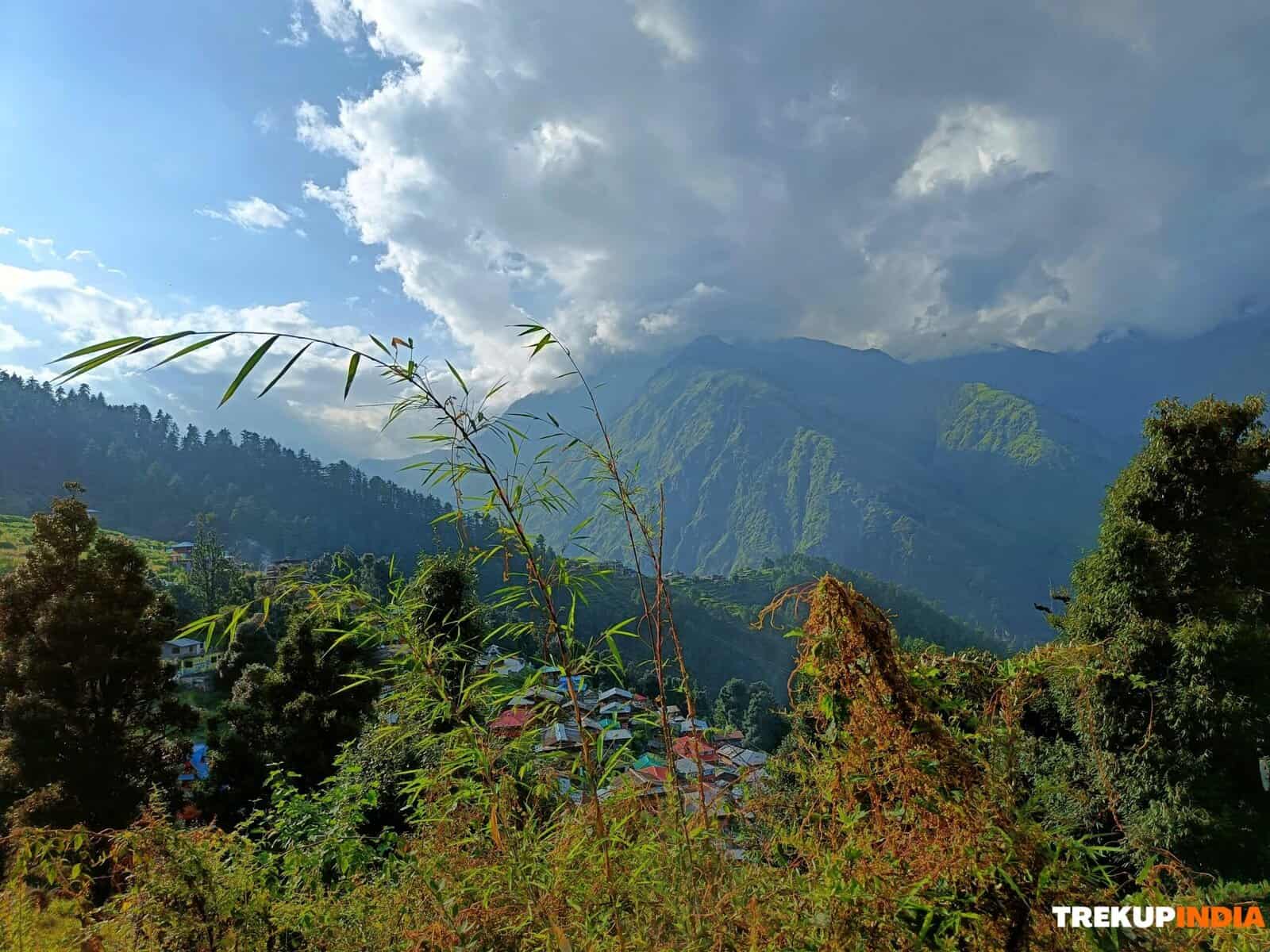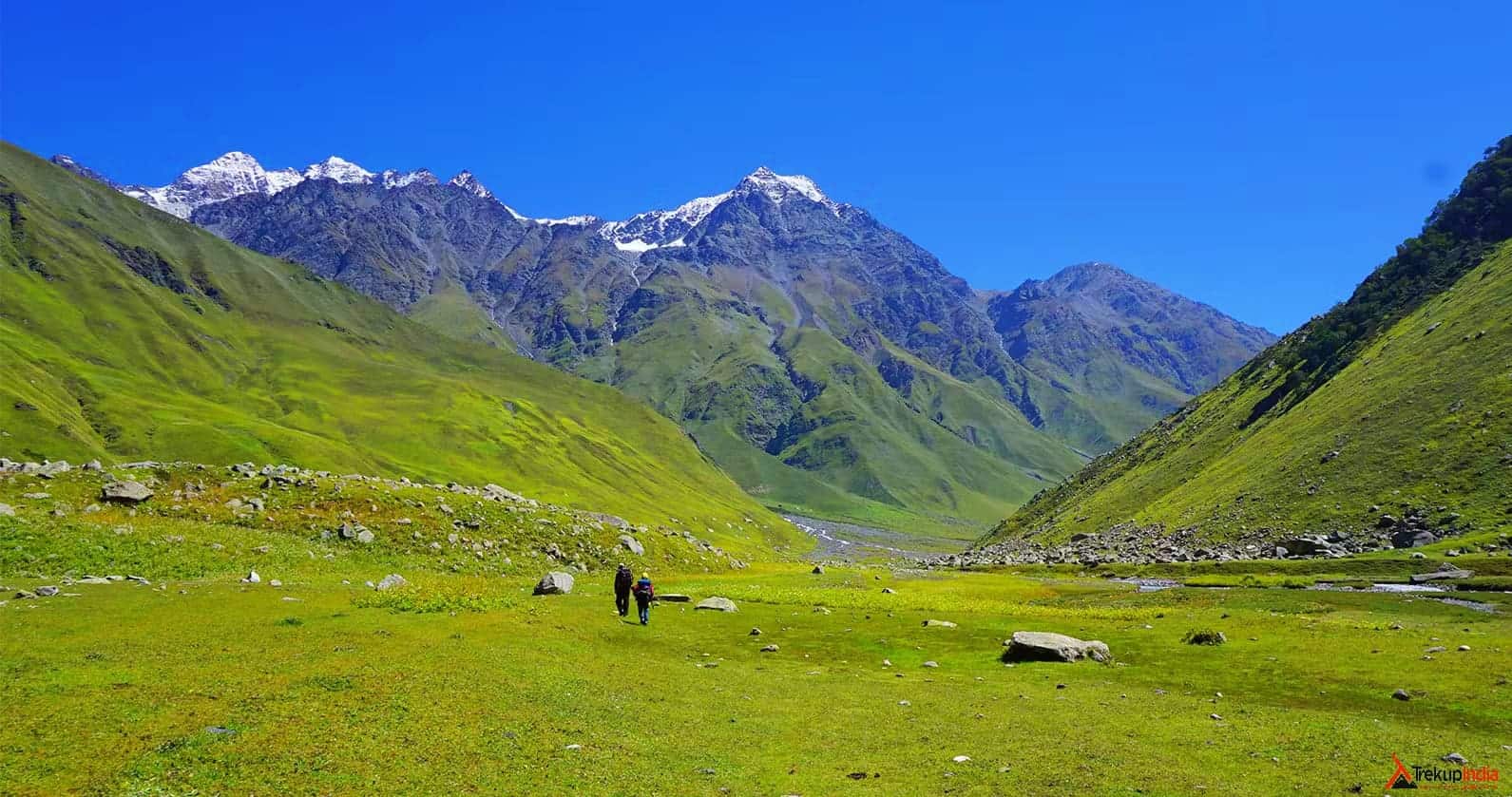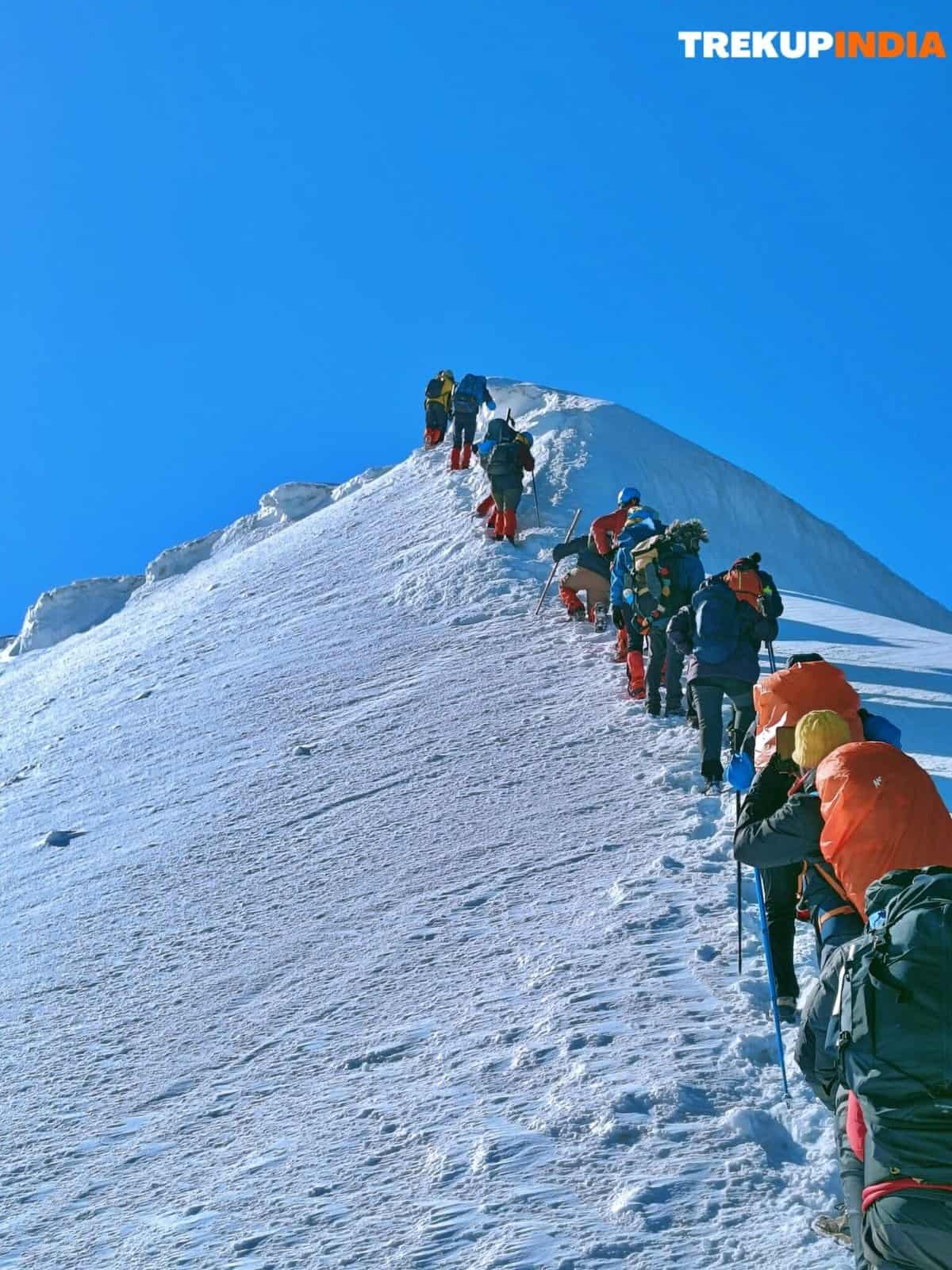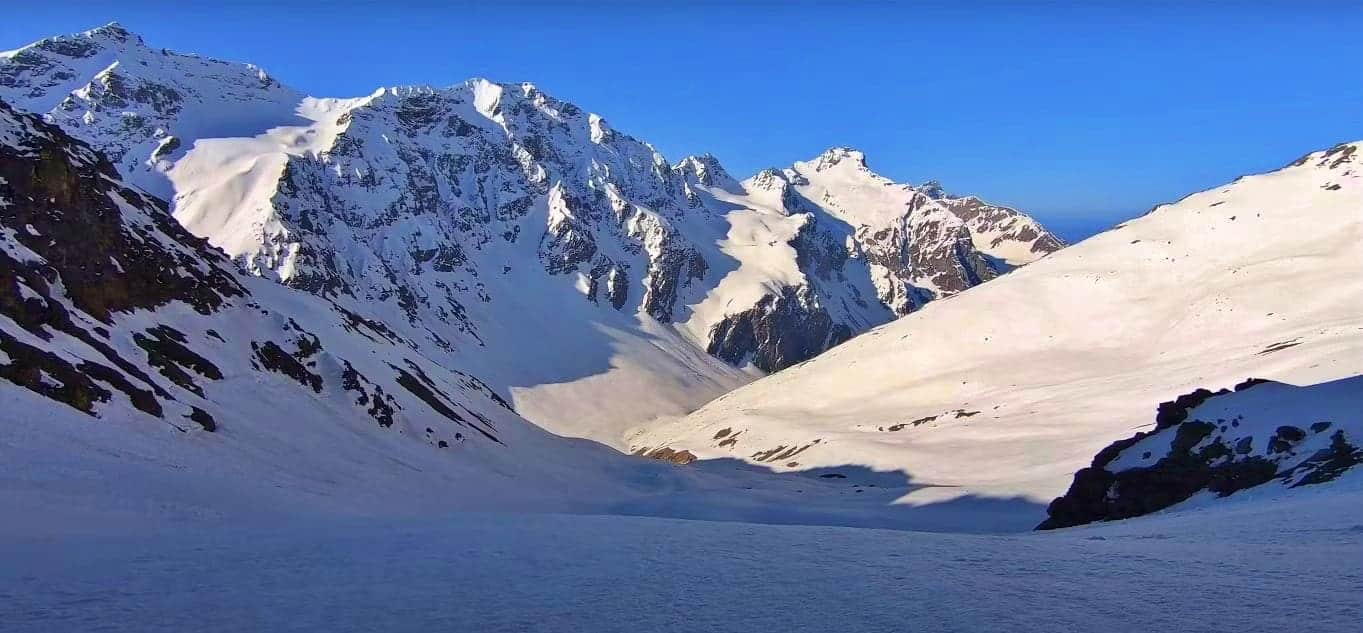30+ Years Of Trusted Trekking Expertise | Crafting Memories Since 1993
Trek Grade
Moderate to Difficult
Highest Altitude
15,250 ft
Base Camp
Jiskun
Best Time
May, June & Sept, Oct
Trek Distance
41 Km
Not sure which trek is right for you? Trekup India’s Mountain Experts have you covered.
Not sure which trek is right for you? Trekup India’s Mountain Experts have you covered. From figuring out if a trek matches your fitness level to knowing who you’ll be trekking with, we’re here to answer all your questions. Reach out to our Mountain Experts and plan your trek with confidence.
Rupin Pass Trek
Rupin Pass is a mountain pass located at an impressive 15,250 feet in the Indian Himalayas, offering an exhilarating and diverse trekking experience. The journey to this lofty altitude is filled with unexpected delights, starting with the drive from Rohru over the Chainsheel Pass. The unpaved roads wind through dense forests, providing breathtaking views that change at every turn. As you ascend to 11,000 feet, the landscape transforms into expansive grasslands that stretch as far as the eye can see, continuing until you reach the Chainsheel Pass.
The Rupin Pass trek is a journey of discovery, full of surprises, starting with the picturesque hanging village of Jakha on the first day. The next day brings the sudden appearance of a towering coniferous forest and, if trekking early in the season, a snow bridge, all of which are sure to leave trekkers in awe. Further surprises include the isolated Saruwas Thatch and the stunning Rupin Pass Waterfall, which plunges an astonishing 1,500 feet, exceeding all expectations.
Dhanderas Thatch boasts a perfectly shaped glacial valley with numerous waterfalls cascading down, leaving observers in awe of its natural beauty. The trek continues to the expansive snowfields of Rata Pheri, offering an unexpected alpine experience. Trekkers will be captivated by the stunning Rupin Gully panorama and the thrilling adventure of the daunting climb to Rupin Pass. The descent to the Ronti Gad campsite offers new surprises, ensuring that trekkers remain captivated until their journey ends in Sangla.
The Rupin Pass trek is renowned as one of India’s top treks due to its unique blend of high-altitude adventure and ever-changing scenery, making it a must-visit for trekking enthusiasts.
The Rupin Pass trek is an exhilarating high-altitude trek that begins from Jiskun and ends at Sangla. With an altitude of 15,250 feet and a total trekking distance of 40.2 kilometres, it is considered a moderate-difficult trek that requires good physical fitness and can be completed in 7 days. The best seasons for this trek are the 1st week of May to June end and mid-September to mid-October. During May and June, temperatures range from 15° to 20° C during the day and 4° to 7° C at night, while in September and October, temperatures range from 13° to 20° C during the day and 2° to 7° C at night. From early July to mid-September, snow is present in the upper regions from May to October.
Trek Cost
-
Twin-Sharing Tent Accommodation Provided
-
Pickup time 6.00 A.M from Old Bus Stand, Shimla & drop by 12 A.M. - 2.00 A.M on the Seventh day
-
+₹4000 Extra For Transport
Fix Departure Dates!
Trek Cost Inclusions and Exclusions!
Trek Cost Inclusions
- Stay: 4 nights of tented accommodation at individual Trekup India campsites on twin sharing and 2 nights of Trekup India Homestay at Jiskun and Jakha.
- Meals: Trekup India will provide freshly cooked meals during the trek starting with Dinner on Day 1 to Lunch on day 7 (Meals are simple, nutritious, and vegetarian)
- Transport (Optional): Shimla to Jiskun and return from Sangla to Shimla. ( INR 4,000 extra )
- Trek Insurance (Optional): Trekup India recommends that all trekkers consider getting trek insurance. This is optional, but highly recommended. Trek insurance covers unexpected events that may occur during your trek. The cost of the insurance starts from INR 210. Please read more about what is included in the coverage and why it is mandatory on treks.
- Trek Equipment: Sleeping bag, Sleeping tents, Kitchen tent, Dining tent, Toilet Tent.
- Amenities: All utensils, sleeping mattresses (Black foam mats), Crampons, and Gaiters for snow.
- Health & Safety: First Aid Box, Oxygen Cylinders, Stretchers, Oxi meters, BP Machines, health.
- Permits: Forest Permits and Camping Permission Fee
- Trek Crew: High Altitude Chef, Helpers, Trek Leader & Guides, and other support teams.
- Potters & Mules: Potters and Mules are to carry all trekking equipment, ration, and vegetables.
Trek Cost Exclusions
- GST 5% (it is Mandatory)
- Any Meals/accommodation beyond the itinerary or not mentioned in the program.
- Any Bus / Airfare to/from the trek start/end point
- Personal Medical expenses include your medication.
- Any personal services such as Laundry, phone calls, liquor, mineral water, etc.
- Any still / video camera fee
- Any Entrance fee to Monuments, Monasteries, Museums, Temples – Pay directly on the spot.
Backpack Offloading (Mule/Porter Charges)
Offload Charges: ₹3780 per bag for the full trek if paid online in advance.
On-spot Payment: Charges may increase by up to 30% if paid at the base camp.
Weight Limit: Each bag must not exceed 10 kg.
Note: Offloading is optional and is recommended for those who prefer to trek with a lighter daypack.
- Any emergency evacuation charges
- Any services that are not mentioned in the cost inclusion section.
Rupin Pass Trek Videos
Videos by experts watch these videos to prepare well for a Successful Trek
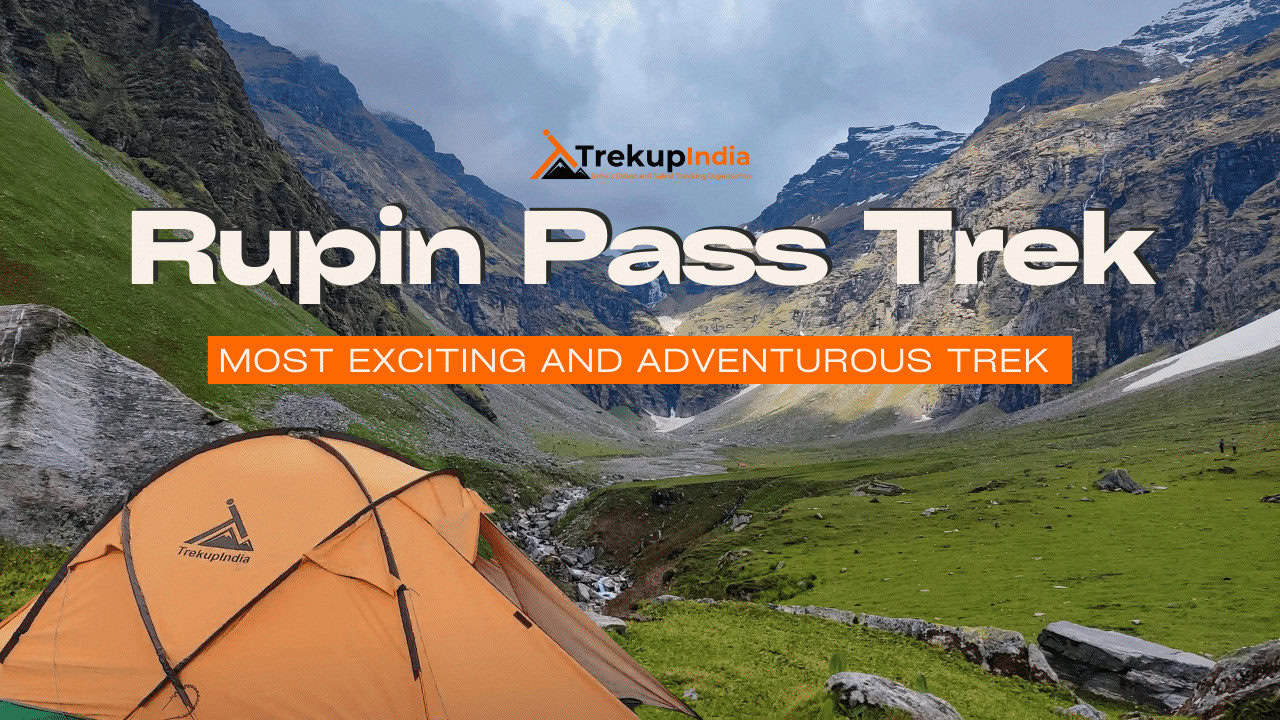
Want To Trek Like Pro?
Basically, watch these videos if you want to trek the same way professional trekkers do and make your skills better. These videos contain useful tips and techniques to further improve your trekking skills itself. These videos actually help both new and experienced trekkers improve their trekking skills. These videos definitely provide useful tips that make your trek better. We are seeing that these videos by Trekup India experts will only help you make your trekking skills better.







Know Everything About Acute Mountain Sickness
Acute Mountain Sickness occurs when people trek to high altitudes above 8,000 feet. This condition itself develops further due to reduced oxygen levels at such heights. Basically, as you go higher up, the air pressure and oxygen levels decrease, which causes the same problem. Acute Mountain Sickness surely causes headache, nausea, vomiting, and dizziness in affected persons. Moreover, peoples also experience difficulty in sleeping during this condition. To avoid mountain sickness, you should actually trek up slowly to higher altitudes. To learn further about this condition itself, watch the videos by Trekup India.



Day Wise Detailed Itinerary of Rupin Pass Trek
Day 01 : Shimla to Jiskun by Drive
- Altitude: 7,700 feet
- Drive Distance: 205 Kms
- Drive Duration: 10 Hrs
- All the trekkers will be picked up from Shimla old bus stand at 06:00 am in a four-wheeler like bolero, traveler or any other vehicle’s
- Only dinner is included, not the breakfast and lunch
- Night stay will be organized in the Home Stay, Guest House
- Last Network till Chanshal Pass, Jiskun & Jakha
- Last ATM Rorhu
The weather will be cold on the first day of your journey to Jiskun by vehicle. Be prepared to see stunning views of nature and hills that amaze you. If you love nature, have your camera ready, as the scenic views are indescribable. You will travel to Jiskun through Rorhu, a town on the river Pabbar, located approximately 110km from Shimla, Himachal Pradesh. You will cross the Chaaisheel Valley to Rupin Pass basecamp – Jiskun. Instead of the traditional Rupin Pass trek itinerary from Dehradun to Dhaula, the road through Chainsheel Valley has improved, so we prefer driving from Shimla to Bawta. As the road from Rorhu splits into two routes, the first road leads to Janglik, the base camp for the Buran Ghati trek, while the second goes to Jiskun, the base camp for Rupin Pass. The drive will be through the beautiful and scenic Chainsheel Valley. After the long 8-10 hour journey, you will be served delicious meals to regain strength.
Day 2: Trekking 4 kilometers Uphill from Jiskun to Jakha
- Altitude: 8,700 ft
- Trek Distance: 4 Kms
- Trek Duration: 4 Hrs
- It is a 4 km trek with a difficult level of ascent and a steep climb
- Within 04 hours, you will reach Jakha from Jiskun
- Hot lunch at the campsite and tea & Maggi stalls are available on the way
- Moderate climb till Jiskun and then descent till the wooden bridge and zig-zag trail till Jakha
- Selwan Khad is the last water point
- Night in a homestay or tents
Embark on a 4-kilometre journey to Jakha, the final and highest village on the Rupin Pass trek. Leaving Jiskun, the path descends through a dense forest of towering deodars and walnut trees, eventually leading to a captivating, shadowy gorge in the mountain. The upper reaches of this gorge are inaccessible to humans, creating an air of mystery. You’ll glimpse the remnants of an old wooden bridge almost hidden by vegetation. Below, you’ll traverse the new wooden bridge and gaze upward at the eerie, rock-cut path that seems almost otherworldly. Please take a moment to appreciate the marvel of its construction.
The subsequent hour-long ascent to Jakha unfolds on one of the most magnificent trekking trails. The scenery constantly changes as the path zigzags upward along the ridgeline, leading through a mesmerizing mixed forest accompanied by bird songs. Be cautious to avoid taking a diverging trail to the left, which leads to the village of Dhara, situated above Jakha. Instead, veer to the right to stay on course.
The village of Jakha is deeply rooted in the principles of Satsang, and as such, it is a meat-free zone. The campsite, situated just above the town, doubles as a playground for the local children. Alternatively, the school courtyard can also serve as a campsite. Jakha is the final opportunity to restock supplies and seek out porters if needed, as the next few days of the trek will be largely solitary, except for occasional encounters with shepherds tending to their livestock. This isolation persists until Sangla’s arrival.
Day 3: Easy Trek from Jakha to Saruwas Thatch
- Altitude: 10,770 ft
- Trek Distance: 7 Kms
- Trek Duration: 4-6 Hrs
- It is a 7 km long trek that will take 4-6 hours.
- Long walk, but easy, and most of the walk is along the river, so you will enjoy
- Bottles can be filled from the river
- Snow bridges and wildflowers
- Hot lunch will be provided.
- Stay in a tent on a sharing basis
The trail beyond Jakha leads to a stunning coniferous woodland, where majestic blue pines and occasional maple trees create an unspoiled and serene environment. As you descend, you’ll encounter a surprising expanse of snow forming a natural bridge over the Rupin River, providing a breathtaking experience. In extreme summer heat, the snow bridge may become impassable due to melting, but an alternative route is available, including a sturdy wooden bridge that spans the river. The path narrows along a small track, eventually leading to a wooden bridge and the inaugural expanse of Udakanal’s lush grasslands. The landscape unfolds with a distinct character, frequently paralleling the winding route of the Rupin River, which is fed by numerous small streams cascading down from the mountain’s upper slopes. After a 90-minute hike, the path ascends towards a dense stand of trees, passing by a picturesque spot known as Burans Kandi. Downstream, the Rupin River flows with turbulent waters while massive swaths of snow cling to the mountain gullies. As you ascend, you’ll find yourself enveloped in a stunning sea of Rhododendrons, leading to a more extensive clearing where a charming little island covered in a vibrant carpet of green grass awaits, nestled in a meadow with the Rupin River on your left.
Day 4: Trek from Saruwas Thatch to Lower Waterfall (Dhanderas Thatch)
- Altitude Gain: 10,770 ft/11,700 ft
- Trek Distance: 4 Kms
- Trek Duration: 2-3 Hrs
- Consider exploring the following half-day trekking route from Saruwas Thatch to Danderas Thatch.
- This 2-3 hour journey involves an elevation change from 10,770 feet to a peak of 11,700 feet and is rated as simple, making it the easiest day of the entire trek.
- This visually pleasing trek takes you through petite grassy areas that burst with vibrant blooms in the warmer months and a kaleidoscope of colours in the fall.
- The journey concludes at the renowned Dhanderas Thatch or Lower Waterfall camping spot, positioned at the foot of the 1,490-ft Rupin Waterfall.
As you stand at the edge of the U-shaped valley at Saruwas Thatch, prepare to be inspired by a breathtaking sight: countless silvery waterfalls cascading down the valley’s slopes, merging with the Rupin River. In contrast, expansive emerald meadows adorned with vibrant yellow marigolds stretch before you. The Rupin River flows gently through the rolling hills, creating a picturesque landscape enhanced by scattered patches of snow.
Descending into the valley filled with yellow marigolds. Your first challenge awaits: a snow bridge spanning the Rupin River. Brace yourself for a steeper incline than expected as you carefully ascend the snow bridge. Despite the short-lived steep section, crossing the snow bridge is an exhilarating experience, leading you swiftly to the left side of the Rupin.
The trail winds upward through the vibrant meadows, where you will encounter small, babbling streams and colourful wildflowers. The serene Rupin River flows alongside, its crystal-clear waters glistening with a hint of icy blue.
Continuing along the riverbank, you will come across a broad riverbed and a massive snow bridge, which marks the starting ascent to a high plateau.
The ascent offers slow suspense, gradually building anticipation for the next breathtaking vista. As you reach the stunning meadow, you may even be tempted to pitch your tent in this captivating Himalayan campsite. Nestled in the valley’s heart, you will be surrounded by natural wonders, including a three-tiered waterfall, the majestic Dhauladar Range, and snow-capped valley walls punctuated by numerous waterfalls. The best time to visit is during the summer months when the weather is mild and the meadows are in full bloom.
Rest assured, water will not be a concern as clear icy streams flow nearby in every direction. Set up your tent and immerse yourself in the beautiful natural surroundings at Dhanderasatch, which features a stunning landscaped lawn.
Day 5: Trek from Dhanderas Thatch (Lower Waterfall) to Upper Waterfall Camp
- Altitude: 13,120 ft.
- Trek Distance: 3.5 Kms
- Trek Duration: 3-5 Hrs
- It is a picturesque day of the trek with 3.5km, 3-5 hours
- You can refill your bottle from small streams
- Moderate level of ascent along with a complicated climbing trail around the snow patches
- Do not get on the snow patch directly
- Hot lunch at the campsite
As you embark on your journey towards the ‘Upper Waterfall,’ you’ll be greeted by the vibrant yellow blooms of Marigold adorning the landscape, offering a feast for the eyes. We will provide technical equipment and impart essential knowledge about altitude-related precautions to ensure your safety. Additionally, we will conduct a brief training session to equip you with the skills required for snow trekking, including sidestepping, sliding on snow, and cutting through the snow.
Your initial destination will be the lower waterfall, where you will navigate through ice using an ice axe. Upon reaching the lower waterfall, you’ll encounter a breathtaking snow bridge spanning the Rupin River, following several challenging climbs. Upon reaching this bridge, you’ll be greeted by a captivating environment that will invigorate you and leave you in awe.
Despite a steep ascent, upon reaching the upper waterfall camp at an altitude of 13,100 ft., you’ll realize that your efforts were worthwhile. Take a moment to absorb the panoramic views from this camp, immerse yourself in the unique beauty, and prepare to experience a profound sense of fulfilment. This experience will instil in you the confidence and strength to continue your trek towards the Rupin Pass the following day.
While day six promises adventure, the subsequent day will be more exhilarating and filled with anticipation. Once you cross the bridge, you can look forward to unwinding and savouring your time at the campsite before indulging in a well-deserved dinner.
Day 6: Climax day - Upper Waterfall to Rupin Pass to Ronti Gad
- Altitude: 13,420 ft
- Trek Distance: 9 Kms
- Trek Duration: 10 Hrs
- It is a 9km trek and the most exciting day, where you will pass through a tough level of ascent
- Till the pass, there is a steep ascent and then a steep descent
- You will take an almost 10-hour trek
- By 04:30 am, leave the camp and carry your hot water from the camp as water sources are limited
- A packed lunch will be provided
- In the late evening, we will be reaching Ronti Gad
On day 6 of the trek, it’s essential to wake up early as it will be a long day of trekking. After breakfast, the trek to Rupin Pass, which stands at 4,650 meters, will begin. It’s crucial to carry all necessary trekking equipment for a safe journey. The trek includes a steep ascent to Rati Pheri and a break to appreciate the remarkable changes in nature. The trail is covered in snow, offering a breathtaking view of Rupin Pass. Trekking through rocky terrain requires caution due to loose rocks and potential falling stones. Climbing individually is recommended to avoid difficulties. Despite the tiring ascent, reaching the summit will be uplifting, offering colourful flags and a stunning view of the Dhauladhar Range. Descending from the summit is fun and leads to the pastures of Ronti Gad, which are distinct from previous sights on the trek. Ronti Gad features snow-covered mountains and captivating meadows. After a long and eventful day, resting in tents will be necessary.
Day 07: Trek from Ronti Gad to Sangla & Drive Back to Shimla
- Altitude: 8,800
- Trek Distance: 12 Kms
- Trek Duration: 10 Hrs
- Drive Distance: 210 Kms
- Drive Duration: 9-10 Hrs
- Last day of trekking, you will trek for 12 km
- Till Sangla, moderate level of descent
- Several water points on the way
- You will reach Sangla by 1-2 pm
- The cab will leave from Sangla at 3 pm and reach Shimla by 2 am the next day
- Drive back to Shimla (9-10 hours)
- Make your bookings for a hotel in Shimla accordingly
The trek to Sangla offers a diverse and rewarding experience, with shifting landscapes and stunning views of the Kinner Kailash range and Baspa Valley. Starting the morning at a relaxed pace is recommended, as the descent involves quickly changing altitudes and can become quite hot near Sangla, especially compared to the cold elevation of the Rupin Pass.
The shepherd’s route from the campsite descends towards the valley, where you may encounter shepherds and their herds. After an hour and a half and a descent of more than 1,500 feet, the path opens to a breathtaking view of the valley above the Rukti Gad, with the snow-covered Nalgan pass visible on the right.
As you descend, the meadows cover the mountainside, hiding the snow from view, and the majestic Kinner Kailash range looms ahead. The sight is awe-inspiring and leaves trekkers rooted to the spot. The Sangla Kanda Lake and a small village become visible as you descend towards the town, offering a welcome rest stop with friendly locals and hot tea.
Multiple pathways radiate from Sangla Kanda towards Sangla, and following any route veering to the right will eventually lead you to the primary route, hugging the lake’s perimeter. The landscape transitions from dense foliage to a forest of blue pines as you continue towards Sangla, walking alongside the Rukti Gad river.
The path eventually widens and descends, leading to Sangla, where charming wooden cottages and terraced fields come into view. The dense forest of blue pine trees gives way to lush apple groves, marking a return to civilization. After crossing the Baspa River bridge, a challenging 20-minute ascent leads to the paved road in Sangla. Multiple concrete pathways guide you to the main road, and you can inquire about the location of the bus station, which is marked with painted signs.
Restaurants and accommodations are available in Sangla, offering affordable bed and bedding options. The final bus bound for Shimla departs at 5:00 pm and arrives in Shimla at 3:00 am the next day.
Rupin Pass Trek Route Map
We’ve prepared a comprehensive Trek Route Map for your upcoming adventure to Rupin Pass Trek, which outlines the entire journey including all stops and trails. This map provides detailed information on the terrain, distance between points of interest, and estimated travel time to help ensure a safe and enjoyable trek. We’ve carefully curated the map to ensure that you have all the necessary information at your fingertips. Please take a moment to review it thoroughly, and don’t hesitate to reach out if you have any questions or concerns.
Rupin Pass Trek Altitude Chart
The Trek Altitude Chart is a useful tool for Trekkers to monitor their altitude changes during their rides, allowing them to plan their routes more efficiently and track their progress over time. This Rupin Pass Trek chart is beneficial for both casual and experienced Trekkers, helping them make the most out of their Trek experience.

Trek Cost Inclusions
- Stay: 4 nights of tented accommodation at individual Trekup India campsites on twin sharing and 2 nights of Trekup India Homestay at Jiskun and Jakha.
- Meals: Trekup India will provide freshly cooked meals during the trek starting with Dinner on Day 1 to Lunch on day 7 (Meals are simple, nutritious, and vegetarian)
- Transport (Optional): Shimla to Jiskun and return from Sangla to Shimla. ( INR 2,500 extra )
- Trek Insurance (Optional): Trekup India recommends that all trekkers consider getting trek insurance. This is optional, but highly recommended. Trek insurance covers unexpected events that may occur during your trek. The cost of the insurance starts from INR 210. Please read more about what is included in the coverage and why it is mandatory on treks.
- Trek Equipment: Sleeping bag, Sleeping tents, Kitchen tent, Dining tent, Toilet Tent.
- Amenities: All utensils, sleeping mattresses (Black foam mats), Crampons, and Gaiters for snow.
- Health & Safety: First Aid Box, Oxygen Cylinders, Stretchers, Oxi meters, BP Machines, health.
- Permits: Forest Permits and Camping Permission Fee
- Trek Crew: High Altitude Chef, Helpers, Trek Leader & Guides, and other support teams.
- Potters & Mules: Potters and Mules are to carry all trekking equipment, ration, and vegetables.
Trek Cost Exclusions
- GST 5% (it is Mandatory)
- Any Meals/accommodation beyond the itinerary or not mentioned in the program.
- Any Bus / Airfare to/from the trek start/end point
- Personal Medical expenses include your medication.
- Any personal services such as Laundry, phone calls, liquor, mineral water, etc.
- Any still / video camera fee
- Any Entrance fee to Monuments, Monasteries, Museums, Temples – Pay directly on the spot.
Backpack Offloading (Mule/Porter Charges)
Offload Charges: ₹3780 per bag for the full trek if paid online in advance.
On-spot Payment: Charges may increase by up to 30% if paid at the base camp.
Weight Limit: Each bag must not exceed 10 kg.
Note: Offloading is optional and is recommended for those who prefer to trek with a lighter daypack.
- Any emergency evacuation charges
- Any services that are not mentioned in the cost inclusion section.
What should you pack for the Rupin Pass Trek
Rupin Pass Trek is a high-altitude trek. The trekking gear you have to have for this particular trek differs from normal treks. Thus, read this whole segment. There is an important question that the trekker who is doing trek asks, like what all things to carry while trekking. Below, we have provided the details on everything you should take; an easy way to remember is by Head to foot or foot to head. We have prepared from Head to foot.

Head Gears
When trekking it's important to carry headgear to protect your head and face.
Heading out for a trek? Don’t forget to carry headgear to protect your beautiful face and head from the sun, wind, and dust! It’s an essential accessory that keeps you safe and comfortable throughout your adventurous journey. So, make sure you pack it before you step out into nature!
- Head Lamps – When trekking at night, headlamps are essential to illuminate your path while keeping your hands free. Headlamps come in different sizes and lumens, so it is essential to choose one that suits your needs.
- Hats or Cap – Caps or hats are also necessary when trekking in different weather conditions. Caps protect your head from the wind and freezing temperatures at night, while hats provide shade and protection from the sun during the day. It’s essential to ensure that your hat has a strap to prevent it from being blown away by the wind.
- Sunglasses – Sunglasses are also essential for trekking. Your sunglasses should protect your eyes from harmful UV rays and fit your face perfectly to avoid falling off while climbing, jumping, or crossing obstacles. The glass of your sunglasses should also be designed for different weather conditions to provide optimal visibility.
- Buff / Balaclava – Lastly, a buff or balaclava is a must-have to protect your mouth or neck from extreme temperatures and keep them warm. Buffs and balaclavas come in different materials, thicknesses, and designs, so it’s important to choose one that suits your needs and preferences. Depending on the weather conditions and your activities, you can wear them as neck warmers, face masks, or headbands.
Clothes
When trekking in high altitudes, prepare for cold weather by wearing layers. Layering traps heat, keeps you warm, and allows you to easily adjust your clothing as temperatures fluctuate.
Layering is important for different seasons when trekking. When planning a high-altitude trek, it is important to prepare for the cold weather. Wearing layers is the best approach as it provides both protection and flexibility when the weather changes frequently in the mountains. Layering helps to trap heat and keep your body warm, while at the same time allowing you to easily adjust your clothing as the temperature fluctuates. By wearing layers, you can enjoy your trek comfortably and stay safe in the unpredictable mountain weather
- For spring, summer, and monsoon treks, consider wearing three layers: a woollen sweater, a fleece, and a padded jacket.
- For autumn treks, add one more fleece layer to make it four layers.
- For winter treks, you may need five layers with thermals, a woollen sweater, two fleeces, and a padded jacket.
- T-shirt/sleeve shirt– Bring three T-shirts and two quick-dry trek pants, wearing one and carrying the others. Long sleeve shirts help to protect from sun UV rays. We recommend synthetic T-shirts as they get dry quickly when they get wet.
- Hiking / Trekking Jacket– down jackets (-5 to-10 C) or two-three-layer jackets.
- Thermals– at least two pairs of thermals help keep the body warm during cold weather.
- Undergarments– you can carry them according to your habitual and hygiene requirements.
- Gloves– 1 pair of gloves will keep your hand warm and nice.
- Trek Pants– Bring 2 to 3 comfortable trekking pants. Trekking pants play a significant role, as they are designed for comfort and mobility, making trekking easier. It should be Synthetic so that it gets dry quickly when wet.
- Rain Wear– you can carry a raincoat or Poncho. During long rains and snowfalls, the waterproof jackets start leaking. Still, the Poncho and raincoats keep you dry, so choose accordingly.
Tip: If you choose a raincoat on your trek, carry a small waterproof cover so things inside your backpack can’t get wet. If you carry a Poncho, you don’t need to worry. It protects both you and your backpack.
Foot Gears
When it comes to planning a trek, one of the most important aspects is to ensure that you have the right kind of foot gear.
- Trekking shoes which are waterproof and have ankle support. Walking / Hiking sandals which can be used off the trek, i.e., in the morning and evening hours when you reach the campsite, basically to get your feet rest from heavy boots, sometimes used for crossing streams and rivers, it’s more comfortable and safer than crossing barefoot or wetting your shoes. Sneakers (Optional) can be worn for normal driving days or used around the camp.
- Socks– you should at least carry 3 to 4 pairs.
- Microspikes & Gaitorswill be provided by Trekup India when required. You don’t have to carry them.
Personal First Aid Kit
Don't forget to pack your personal first aid kit! It's always better to be safe. So, make sure you're prepared for any unforeseen circumstances.
Below are some common medicines generally required/used during your adventure trip; however, please consult your doctors prior.
- Antiseptic towel or water syringe (to clean the wound)
- Butterfly bandage for a small cut
- Cotton and elastic bandages and sterile gauze pad for larger wounds
- Latex gloves are used when the wound bleeds.
- Medicine for Diarrhea (Upset stomach)
- Medicine for cold, flue/fever, headache
- Some pain killers
- ORS pouches
- Quick pain relief spray (External use)
- Any personal medicine prescribed by your doctor
- Dimox / Similar for high altitude sickness
- Bug Repellent
- Carry some nutria/energy bars and drinks (non-alcoholic)
- Note: Kindly consult your doctor before purchasing or taking any medicine.
Gadgets and Other Items
You might also consider bringing a camera, binoculars, portable charger, and snacks. Be well-prepared and tackle any trail with confidence.
- Trekking Poles
- Mobile phone
- Camera
- Spare batteries for phone and camera, power bank
- Lightweight flashlight or headlight
- A waterproof bag made of plastic is used for the camera.
- Plug/converter for electrical items
- 1-litre water bottle
- A journal with a pen would be a good idea to keep your notes.
- Some book of your interest for the ideal time
- Get into the habit of maintaining a Map and guidebook of the region.
Hygiene & Personal toiletry
Remember to pack hygiene and personal toiletry items such as soap, shampoo, toothbrush, toothpaste, deodorant, and toilet paper.
- Sunscreen with UV protection to shield your skin from harmful rays
- 1 or 2 small quick-drying towels to help you dry off quickly in case of rain or sweat
- Toilet paper, tissues or wet wipes for maintaining hygiene while on the trek
- Toothbrush, toothpaste, and mouth freshener to keep your mouth clean and fresh throughout the journey
- Deodorant or talcum powder to help you stay fresh and odor-free, especially during hot and humid climates
- Shampoo to keep your hair clean and healthy
- Sanitary pads or tampons (for female trekkers) to manage menstrual cycles
- Lip-gloss or salve to protect your lips from dryness and chapping
- Bio-degradable soap to keep yourself clean and hygienic while on the trek
- Nail clipper and other personal items that you use daily
Compulsory Documents to Carry
There are certain documents that you should always carry with you. These documents are not only necessary for your safety and security, but they may also be required by local authorities.
These files must be submitted to the Forest Department before your trek. With none of these, you will not be permitted to trek—original and photocopy of government photo identity card. Carry IDs like Aadhaar, voter ID, etc.
How To Plan Your Trek & Reach Shimla?
We are delighted to welcome you to the Rupin Pass Trek, a great buffet of some of our most popular treks. It is a fantastic trek, but you must make sure your travel plans are in order.
Here are some tips to help you plan your trip.
Day Zero (the day before Trek Day 1):
- Book your flights to Chandigarh and Delhi.
- If you are in Chandigarh, take a bus to Shimla.
- Book an overnight bus from Delhi to Shimla.
Day 1: Travel from Shimla to Jiskun, your base camp. Transport is organised at 6 am from the old bus station in Shimla.
Day 2 – Day 6: Trek on the Rupin Pass Trail.
Day 7: After a half-day of trekking, drive back to Shimla. The drive from Sangla to Shimla takes about 8-9 hours. You will reach Shimla between 1 a.m. and 2:30 a.m. You should ensure you have booked your hotel accommodation in Shimla according to it.
Day 8: Book your return flight/train. Fly from Chandigarh or Delhi to home.
Our recommendations:
1. We recommend you travel to Shimla early and stay overnight near the Old Shimla bus station. In Shimla, you can rest for the night and visit some sights.
2. On the way back, your trek ends in Sangla, a small tourist town. We will organise transport back to Shimla, which should arrive between 01:00 and 02:30 a.m
How To Reach Shimla?
- By air: Jubbarhatti airport is located 22 kilometres from Shimla. It has excellent flight connections to other cities. You can also reach other nearby airports like Chandigarh Airport or Delhi Airport.
- By Train: Kalka is the nearest railroad station, connecting the city to different parts of the country by rail. You can take trains from cities like Delhi and Kolkata. You can also take the toy train from Kalka Railway Station or hire private cabs to explore the beautiful town of Kalka.
- By Road: Shimla can be connected to cities like Chandigarh and Delhi, Dehradun, Kalka and Dehradun. To reach the hill station, you can hire cabs or government buses. Regular bus services are available from nearby cities like Kullu (235 km), Manali (228 km), Delhi (390 km) and Ambala (154 km). From the Indian capital, you can take luxury buses and cabs for a comfortable ride.
Trekup India arranges for Bulero and similar vehicles to pick you up from Shimla Old Bus Stand at 6:00 a.m. Jiskun will be reached at 5:30 p.m. Please note that the price does not include food during the journey from Shimla to Janglik and back.
Fitness Required & Preparation Guide For Rupin Pass Trek
If you’re preparing for a Rupin Pass Trek, Trekup India recommends jogging as part of your fitness routine. Jogging helps work out the same muscle groups that you’ll use during trekking and can help you build endurance. You don’t need any special equipment to get started.

Fitness Target
Trekup India has put the Rupin Pass Trek into an moderate to difficult grade-level trek.
For Moderate – Difficult Treks – In order to be well-prepared for your upcoming trek, it is recommended that you focus on building your endurance by aiming to cover a distance of 4.5 kilometers in less than 40 minutes. This will help you to develop the necessary stamina and strength required to successfully complete your journey.
How to Achieve This Fitness Target?
To start preparing for your trek:
- Try jogging for at least five days every week.
- If you find 5 km too difficult at first, begin with 2 km and gradually increase over 2-3 weeks.
- Once you feel more comfortable running 5 km, focus on improving your speed gradually on a daily basis.
It is important to ensure that you can consistently complete 4.5 km in under 40 minutes for at least two weeks before your planned trek. Allow yourself 6-8 weeks to prepare physically for the journey.
Strength Training exercises that benefit Trekking
Trekking is an activity that demands a good level of strength.

Trekking is a demanding activity that requires good cardiovascular endurance, muscular strength, and overall fitness. To help you prepare for your trek, incorporating bodyweight exercises into your training routine can be an effective way to build strength, improve stability, and enhance endurance, all of which are crucial for a successful trek. In this regard, here’s a breakdown of body weight exercises categorized by the specific body parts they target and the benefits they offer during trekking.
1. Lower Body Exercises
Lower body exercises like squats and lunges are great for building lower body strength, essential for trekking.
a. Squats
Squats are an excellent exercise for building lower body strength, essential for trekking. They target the quadriceps, hamstrings, glutes, and calves. Solid quadriceps and glutes provide power for ascending and tackling uphill climbs, while vital hamstrings aid stability during descents. This is particularly helpful in navigating uneven terrain during trekking.
How to perform Squats Exercises:
- Stand with feet shoulder-width apart, toes pointing slightly outward.
- Lower your body by bending your knees and hips, keeping your back straight.
- Lower until your thighs are parallel to the ground or as low as comfortable.
- Push through your heels to return to the starting position.
b. Lunges
Lunges target the quadriceps, hamstrings, glutes, and calves. They improve lower body strength, balance, and stability, crucial for maintaining control on rocky trails and steep slopes. Additionally, they enhance flexibility, reducing the risk of injury while trekking.
How to Perform Lunge Exercises:
- Stand with feet hip-width apart, hands on hips or sides.
- Take a step forward with one foot, lowering your body until both knees are bent at 90-degree angles.
- Push through the heel of your front foot to return to the starting position.
- Repeat on the other side, alternating legs.
2. Upper Body Exercises
Upper body exercises such as push-ups and pull-ups effectively strengthen the upper body, especially the chest and shoulders, which are essential for carrying a backpack during treks.
a. Push-Ups
Targets: Chest, shoulders, triceps, and core.
Benefits for Trekking: Push-ups are an effective exercise to strengthen the upper body, especially the chest and shoulders, essential for carrying a backpack during treks. Improved upper body strength will also help maintain posture and stability while traversing challenging terrain.
How to Perform Push-Ups Exercises:
- Start in a plank position with hands shoulder-width apart and body in a straight line from head to heels.
- Lower your body by bending your elbows until your chest nearly touches the ground.
- Push through your palms to return to the starting position.
- Keep your core engaged throughout the movement.
b. Pull-Ups/Bodyweight Rows:
Targeting the back, biceps, and shoulders can significantly benefit trekking. You can strengthen these muscle groups by performing pull-ups or bodyweight rows and improve your posture and balance while carrying a backpack. Additionally, more muscular back muscles can help reduce the risk of back strain and fatigue during long treks, making your journey safer and more comfortable.
3. Core Exercises
Core exercises like planks and Russian twists can help strengthen the core muscles, which are crucial for maintaining stability and balance while trekking on uneven terrain.
a. Planks
Targets: Abdominals, obliques, and lower back.
Benefits for Trekking: Planks are an effective exercise that helps strengthen the core muscles. These muscles are crucial for maintaining stability and balance while trekking on uneven terrain. A strong core also helps improve posture, reducing the risk of back pain and fatigue during extended hikes.
How to Perform Planks Exercises:
- Start in a plank position with elbows directly under shoulders and body in a straight line from head to heels.
- Engage your core and hold the position, avoiding sagging or arching the back.
- Keep breathing steadily and hold for the desired duration.
b. Russian Twists
Targets: Obliques, abdominals, and lower back.
Benefits for Trekking: Russian twists engage the core muscles, particularly the obliques, improving rotational stability and balance. Enhanced core strength helps prevent injuries and improves overall performance during trekking.
How to Perform Russian Twist Exercises:
- Sit on the ground with knees bent and feet flat, leaning back slightly to engage the core.
- Clasp hands together and twist the torso to one side, bringing the hands towards the ground beside the hip.
- Return to the centre, then twist to the other side.
- Continue alternating sides for the desired number of repetitions.
4. Full Body/Cardiovascular Exercises
Full-body/cardiovascular exercises like burpees and mountain climbers are excellent for improving cardiovascular endurance, strength, and agility.
a.Burpees
Burpees are an excellent full-body exercise that targets your legs, chest, arms, and core. This exercise dramatically benefits trekking enthusiasts, improving cardiovascular endurance, strength, and agility. Regularly incorporating burpees into your workout routine can enhance your overall fitness level, which can help you endure long hikes and rugged terrains with ease.
How to Perform Burpees Exercises:
- Start in a standing position.
- Squat down and place hands on the ground.
- Jump feet back into a plank position.
- Perform a push-up.
- Jump feet back to the squat position.
- Explosively jump up into the air, reaching overhead.
- Land softly and repeat the sequence.
b. Mountain Climbers
Mountain climbers target the core, shoulders, chest, and legs. This dynamic, full-body exercise can significantly improve cardiovascular endurance and agility. It is an excellent functional workout for trekking preparation as it engages both the upper and lower body muscles while strengthening the core muscles.
How to Perform Mountain Climbers Exercises:
- Start in a plank position with hands shoulder-width apart and body in a straight line from head to heels.
- Drive one knee towards the chest, then quickly switch legs, alternating in a running motion.
- Keep the core engaged and the hips stable throughout the movement.
- Continue at a moderate to fast pace for the desired duration.
Incorporating bodyweight exercises into your training routine can help you build strength and endurance and prepare your body for the physical demands of trekking. Consistency and proper form are crucial to maximizing the benefits of these exercises and ensuring a safe and enjoyable trekking experience. Engaging your core muscles, including obliques, abdominals, and lower back, with Russian twists can improve your rotational stability and balance, preventing injuries and enhancing overall performance during trekking.
When incorporating strength training exercises into your workout routine, it’s essential to maintain proper form and technique to avoid injury. Start with lighter weights and gradually increase the intensity as you progress, focusing on compound exercises targeting multiple muscle groups simultaneously. Some examples of practical strength training exercises for trekking include squats, lunges, deadlifts, and pull-ups.
Remember to give your muscles time to recover between workouts, and remember to stretch before and after your workouts to prevent injury and improve flexibility. Combining strength training with jogging and proper stretching allows you to take your fitness to the next level and confidently tackle even the most challenging treks.
Our Trekkers Reviews And Expreinces
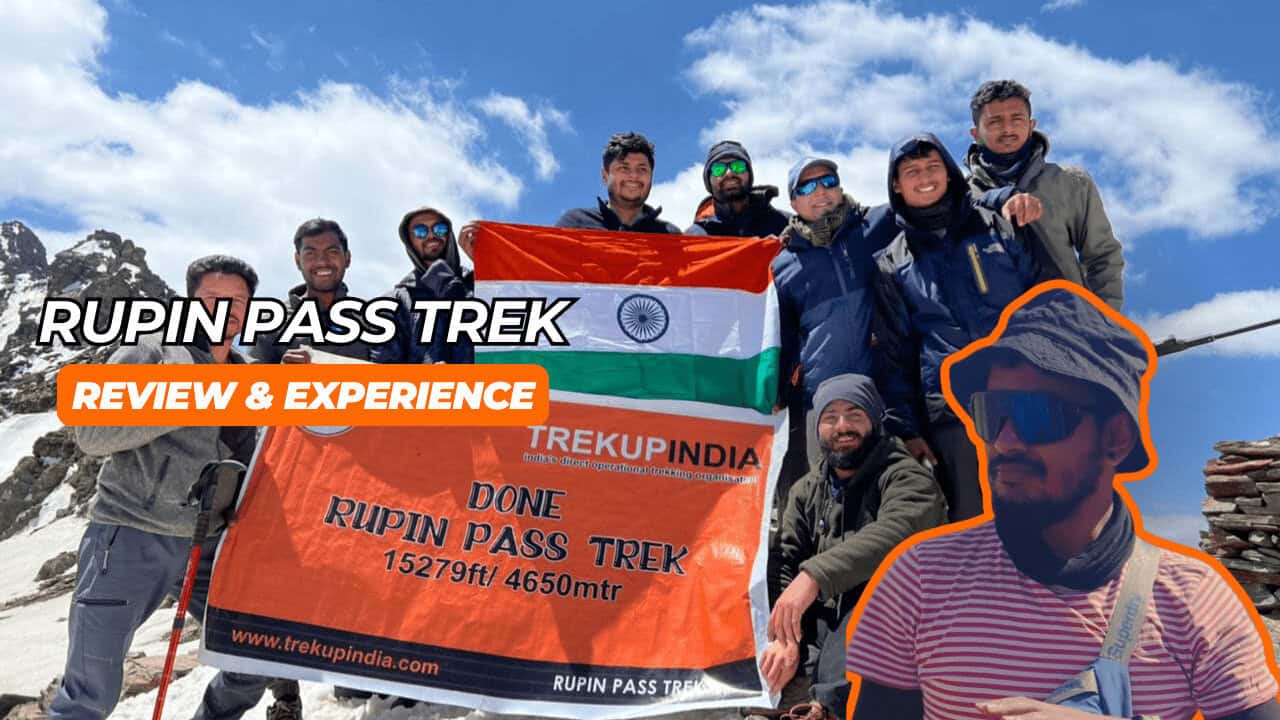

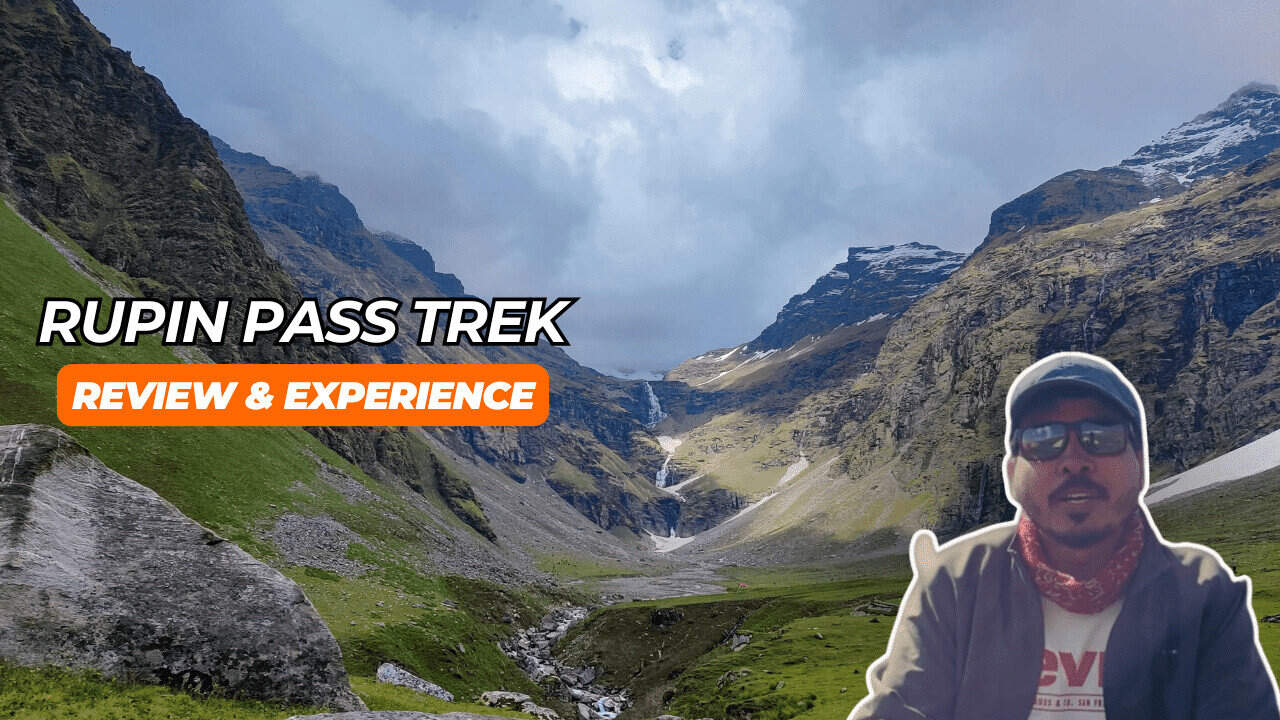
Food Provided by Us During Trek
We provide only Indian vegetarian food, and your meal will mainly consist of Indian bread, vegetables, lentils, rice, and a delicious dessert. During your trek, we will serve three meals a day, including breakfast, lunch, and dinner. You will also be served tea, snacks, and lip-smacking soup in the evening before dinner. If it is a long day of trekking, you will be given a packed snack.
After extensive research on the trekkers’ nutritional requirements, we prepare the menu. Before putting all the meals together, we also consider the altitude and the weather.
The meal we serve during the trek is perfectly balanced with calories, carbohydrates, vitamins, protein, fibre, and minerals. You need to know that all our cooks have great expertise in cooking and have undergone thorough training. So, get ready to enjoy delectable and lip-smacking dishes during your trek. You will be served with lemon tea in the tent to start your day with a refreshed feeling. Before leaving the campsite for trekking, you will be given a hot finger-licking breakfast like upma, Aallu Prantha, Besan Chilla, Poha, Daliya, Corn flakes, and Maggie, along with tea or coffee.
If your trek is longer, we also offer some fresh local fruits such as apples and healthy drinks like Frootie or Maaza. In the afternoon, you will be served a simple & healthy lunch, while at around 04:00 pm, you will be given tea and a light evening breakfast. After you reach your campsite at night, you will be served a hot and delightful dinner.
After reading this, you must have understood the food we provided on the trek; you don’t need to worry about food. Many trekkers repeatedly trek with us because of the food we provide. Thus, we will give you unforgettable experiences.
Safety During Rupin Pass Trek

Trekking with us for the Rupin Pass Trek is entirely safe because we have a team of trek leaders qualified in Wilderness first-aid and complete information about the high-altitude glitches. During the trek, we carry a full first-aid kit that contains all the essential medicines. Before trekking with us, you must ensure that you are medically fit for the trek; for us, your medical fitness is more important than anything else.
Right from our establishment, we at Trekup India have been continuously introducing new safety practices into Indian trekking to ensure the safety of voyagers. Trekup India introduced microspikes and made emergency bottled oxygen mandatory for all treks. Our trek leaders take your daily Pulse oximeter reading. We at Trekup India introduced the radio walkie-talkie as a safety communication device.
How can we ensure that your trek is safe with us?
We have noticed that most trek-organizing organizations do not follow these systems, but with time, they are following us; several competing companies are adopting these practices and organizing great, safe treks.
We ensure complete technical safety in the mountain. Our company has a vast team of more than 100 guides and trek leaders who serve on Himalayan treks. One of the best things about our team is that all the members are trained professionally by the Nehru Institute of Mountaineering, Indian Mountaineering Foundation Delhi, and Hanifle Center Outdoor Education Mussoorie.
Explore our New Safety Protocols
To ensure a perfect Trek, we have introduced some new safety checks to ensure excellent safety for our trekkers.
Our On-trek safety checks include:
- Daily oxygen saturation, along with pulse readings
- Stretchers team appointed on every trek
- Radios
- Trained mountain staff and complete safety
- Additional oxygen cylinders
- Special medical kit for high-altitude treks
- Microspikes on all types of snow treks
- Experienced Trek leaders, as well as safety
- Technical team on all snowy slopes
For Us, Your Safety Is the Top Priority
At Trekup India, you will find a team with local knowledge and fluency in English and Hindi. This helps ensure that you have a fantastic trek. Not only this, but we also pay attention to your health and safety because this is something we cannot ignore. All the team leaders involved in trekking have already undergone several professional courses in first aid, portable altitude chamber training, CPR, environmental awareness training, and advanced wilderness emergency medicine.
We also carry a complete first aid medical kit on every trek and trip we organize. Apart from the medical kit, we take a portable altitude chamber (if needed) and medical oxygen for all high-altitude treks. Our company has significant expertise in organizing all sorts of group adventure holidays for family groups, school and college groups, and friend groups. We have many travel options that suit different fitness levels and travelling styles.
Regardless of the group size, we value each and every member of our trekking groups. Our commitment to personal attention ensures that your needs and safety are always our top priority.
Who we are?
Trekup India has been a stalwart in the Adventure Tourism industry for 30 years. Since our inception, we have been dedicated to providing top-notch treks, voyages, trekking programs, and high-altitude expeditions. Our extensive experience is a testament to our commitment to your adventure and safety.
We organize treks in Uttarakhand, Kashmir, Sikkim, and Himachal while being part of the trekking community; we feature more than 75 documented Himalayan treks. In addition to other outdoor activities, our company also organizes trips for schools, colleges, and families.
Therefore, we maintain the quality of services offered to our valuable customers.
Must Read These Information Of Rupin Pass Trek
Why You Should Do Rupin Pass Trek
The Lower Waterfall Campsite is considered one of the most beautiful destinations in the Himalayas. Nestled in a “U” shaped glacial valley, it sits at the base of a lush green meadow with snow-capped cliffs. The Rupin waterfall, created by the Rupin cascading down from the Dhauladhar range for over 21000 feet, is a prominent feature of the campsite. Spending two days at this location is a luxurious experience.
The Rupin Gully presents a thrilling adventure for trekkers. This half-tube cut from the mountainside features a near-vertical climb of 200 meters, challenging even the most experienced trekkers. The climb is through narrow rocky boundaries and high snow flanks, making it a truly exhilarating experience.
After descending from the pass, trekkers will encounter the grasslands of Kinnaur. The trail descends sharply through endless meadows to Sangla Kanda. The Ronti Gad campsite is nestled amidst these grasslands, offering stunning views of towering, ice-capped mountains and a flowing stream. The meadows of Sangla Kanda, with the backdrop of the Kinnaur Kailash range, are a sight to behold, leaving visitors in awe of their natural beauty.
Best time to do Rupin Pass Trek
The best time for trekking at Rupin Pass is during the months of May, June,, September and october. During this season, you will experience nature at its best.
How Difficult is the Rupin Pass Trek
The Rupin Pass trek is moderately challenging due to various factors such as altitude gain, distance, terrain conditions, weather, and accessibility. The ascent at 15,260 feet presents difficulties, significantly beyond Dhanderas Thatch. During the summer, trekkers encounter snow bridges and snowfields of Rata Pheri and a steep climb to Rupin Gully. In the fall, rope installations may be necessary due to the absence of snow bridges and swift river currents. Tackling the pass typically demands 10 hours of intense effort, regardless of the season. Due to these challenges, Trekup India categorizes this trek as moderately challenging to difficult, emphasizing the importance of prioritizing safety protocols for a secure and successful trekking experience.
Frequently Asked Questions About Rupin Pass Trek
What is the duration Of the Rupin Pass Trek?
The Rupin Pass Trek covers approximately 37 kilometers and typically takes six days to complete. The trail features a dramatic ascent from 7,631 feet to a high-altitude pass at 15,275 feet, offering stunning alpine scenery and diverse landscapes. Known for its challenging terrain and steep climbs, this trek demands proper physical preparation and acclimatization to ensure a safe and rewarding experience.


